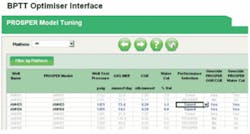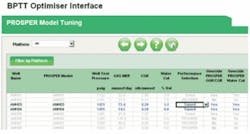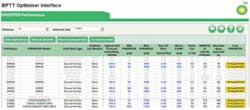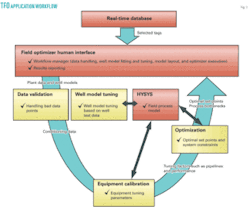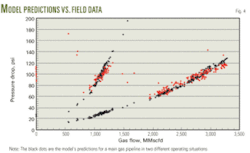BP Trinidad & Tobago (BPTT) has leveraged real-time data with engineering models to manage a complex gas offshore production scheme.
The optimization system:
- Turns real-time data into actionable information.
- Encourages cross-discipline communication by integrating subsea, offshore, and onshore facilities.
- Provides an understanding of the impact of field and process constraints together in production potentials and capacity utilization, including available separation and transportation capacity, pipeline backpressure effects, well operational limitations, and onshore treatment constraints. Treatment constraints include rvp and water content, as well as the capacity of installed stabilization units.
- Helps in meeting contractual obligations in the most profitable way, such as by producing the nominated gas quantities in a way that maximizes the condensate’s revenue stream.
- Allows fast reacts to system upsets and planned equipment outages.
- Provides an in depth understanding of potential new field developments and of required changes in the operating philosophies to maximize investment value.
This first of two articles describes the components of the optimization system; the concluding part will provide examples of how BPTT uses the system.
Operations optimization
Exploration and production operations require the combined expertise of process and control engineers, petroleum engineers, and geologists. These disciplines frequently address problems from different perspectives and often use different modeling tools for helping to make day-to-day decisions.
Unified decision frameworks that consolidate and encompass larger scopes and broader data sources help align otherwise conflicting objectives and allow operations to tackle issues such as:
- Process surveillance monitoring for providing a comparison of actual reservoir performance with simulated expected performance for fault diagnosis or degradation monitoring.
- Production optimization for maximizing gas production with available onshore and offshore equipment; changing operating philosophy or conditions such as pressures, routing, gas lift, water injection, and gas injection, as well as the best use of available equipment capabilities.
- Capacity planning for assessing spare plant capacity and available production potential.
- Maintenance planning for determining the effect of equipment outages on production capacity.
- Contract renegotiation for obtaining the maximum gas nominations and best utilization of spot gas markets.
- Debottlenecking through identification of process bottlenecks and planning of additional investments or redefinition of operating strategies.
To confront these issues BPTT implemented the Trinidad field optimizer (TFO).
The optimizer is an off-line advisory system that links to real-time data sources as well as to modeling and simulation packages (Aspen HYSYS and PROSPER) to provide an overall representation of BPTT’s gas production and conditioning facilities.
BPTT has embedded the tool into its operational decision-making processes, and its hydrocarbon value assurance team will employ it to analyze various real operating value realization scenarios.
The main advantages of such a system are for:
- Reacting in a timely manner to changes in system conditions.
- Managing gas and associated liquids production more efficiently.
- Maximizing revenue.
BPTT operations
BP Trinidad & Tobago holds exploration and production licenses for operating off Trinidad’s east coast; the unit represents about 10% of BP Global’s business.
Currently 11 offshore production platforms feed into 3 offshore processing hubs: Cassia Bravo, Amherstia, and Mahogany Bravo. The hubs have a combined capacity to process 3.75 bscfd of gas and associated liquids.
Four gas pipelines and one liquid pipeline link the offshore platform network to Trinidad’s east coast. The gas pipelines have a combined gas export capability of more than 3.5-bscfd.
Currently, market demand does not constrain the associated crude and condensate production; therefore, these products have an unconstrained revenue value.
BPTT has contracts for supplying natural gas at specific pressures to the domestic market through the National Gas Co. of Trinidad & Tobago (NGC) and to the Liquefied Natural Gas Co. (Atlantic LNG).
These midstream markets represent about 2.7 bscfd in combined demand requirement.
Adopting technologies
Well documented is the importance of addressing the issues of people, process, and technology through the successful adoption of new solutions.1 2 Taking a simplistic approach and focusing on only one or two of the three areas is one of the single most important reasons identified for failed technology adoption initiatives.
In the case of oil and gas producing assets, this is even more important because the industry is under pressure to keep assets producing at full capacity or agreed-upon rates. This leads to most operators being risk-averse.
At BPTT, a team of gas dispatchers ensures that market demand is met 24 hr/day all year. Their operating process includes calling the respective markets to understand the demand profile throughout the day and to ensure that the gas supply meets required operating pressures. They normally manage this process hourly and the work often is time consuming and redundant.
Adoption of the new technology will improve productivity by allowing the gas dispatchers to eliminate guesswork with respect to daily optimization, add additional revenue to the saturated gas business by operating more efficiently in maximizing liquid hydrocarbon production while meeting gas nominations, and reduce the time to react to changes that affect normal operating conditions.
BPTT formed a production optimization team (POT) 3 years ago primarily to manage daily optimization. The team requests inputs from petroleum engineers from each processing hub, gas dispatch team, and market representatives in a daily forum.
The inputs include installed platform capacity (IPC) data, schedules for planned downtimes for both offshore, market activities, and production adding opportunities. By carefully analyzing the data inputs, the team reschedules events affecting production to ensure that BPTT met market demand for any specific day.
BPTT emphasizes maximizing revenues by producing wells with greater condensate to gas ratios. From this, BPTT developed a well priority shut-in list to manage all wells. This list advises operators on which wells to open and close to maintain integrity and maximize crude and condensate production.
The petroleum engineers update the list monthly. Once the personnel reach agreement on the new work schedule and supply profiles, the gas dispatch team works with the well priority shut-in list as a guide to supply demand.
The tedious work flow between the POT, asset engineers, and gas dispatchers requires constant communication to develop a solution to different scenarios. The implementation of the TFO tool simplifies the process for certain issues.
It was equally important to integrate the needs of the shareholders to ensure that the tool is robust so that it satisfies the scenario requests with respect to system optimization.
BPTT’s implementation of the TFO tool required the collaboration of the following technologies:3 4
- Fast running modeling and simulation tools.
- Fast running optimization tools.
- Digitally enabled metering systems.
- Communication systems.
- Real-time databases, process historians.
- User interface infrastructure.
- Work-flow-handling tools.
TFO description
The TFO is a model-based off-line advisory system that uses historical process data and an ad-hoc HYSYS steady-state model to find the values of key process variables that render an optimum production situation that typically leads to meeting a certain gas nomination while maximizing the condensate recovery.
TFO has the following software components (Fig. 1):
- Library of well models—PROSPER from Petroleum Experts Ltd.
- Steady-state field model and optimizer—Aspen HYSYS from Aspen Technology Inc. (TFO model—TFOM).
- Excel executive work-flow managing application (TFO interface—TFOI).
- Data historian—PI from OSI Software Inc.
- MIRS production database—BPTT proprietary implementation.
TFOI acts as the human interface between the optimizer end users and the linked simulation model and databases (Fig. 2). It handles the data traffic between the various system components and, among others, performs the following actions:
- Sensitivity analysis of the individual well models to generate a parametric characterization of the wellhead pressure-flow behavior.
- Retrieval and validation of field data
- Field-model validation against field data including comparison of snapshot model predictions with historic process data.
- Field-model calibration to match actual process conditions.
- Configuration of specific optimization scenarios.
- Presentation of results in terms of potential extra revenues and required actions to achieve them.
TFO design
The essential principles that drove the implementation of the TFO were (Fig. 3):
- Connectivity—The optimizer will have built-in field data retrieval, validation, and visualization mechanisms.
- Flexibility—The optimizer will be dynamically reconfigurable to represent the actual state of asset equipment at all times.
- Fidelity—The optimizer will allow validation against key plant data and be easily tuned when necessary.
- Robustness—The optimizer will run without failure for all possible asset production situations, such as wells, platforms, pipelines, separation trains on or off.
- Usability—The user interface will be friendly and intuitive, providing simple mechanisms to display and visualize model results in a way that effectively communicates among team members.
TFOM
The engine of TFO is a HYSYS model (TFOM) that combines first engineering principles with ad hoc empirical characterizations of critical pieces of equipment, developed from long-term historic process data. This dual modeling approach increases the fidelity of the model without losing any of its predictive capabilities, which are required for meaningful optimization runs.
The TFOM is provided with built-in autocalibration mechanisms that allow its operation in the same field model that eliminate the need of additional parameter estimation models. This one model approach is better than other approaches in that it minimizes optimizer maintenance costs and simplifies application workflow.
An additional advantage is that the same model used for optimization also can serve for what-if analysis and other off-line studies because it is calibrated already against field data.
A key element of the design of field optimizers such as TFO is the ability automatically to activate and deactivate blocks and subsystems. A gas asset such as BPTT is a continuous moving target (Fig. 4). Wells and platforms are shut down and brought on line regularly for such reasons as controlling and adjusting gas productions to demand, performing well tests, and fixing flow-assurance problems.
An optimizer that is unable automatically to detect and react to this dynamic nature of the asset has little value.
The TFOM:
- Allows switching from a validation-calibration mode to optimization mode with a simple flag change.
- Allows activating-deactivating wells, platforms, pipelines, and separation trains through on-off status indicators, with some of them directly retrieved from data historians.
The model has a robustness considerably higher than a standard process simulation typically requires. The model must protect individual pieces of equipment against unfeasible operating regions or provide extrapolation mechanisms to avoid model failures during optimization.
The small inefficiencies and short cuts that will never manifest in a standard simulation model tend to pop up quickly when the optimization engine controls the model.
Some areas that need special attention during construction of the model include:
- Avoiding recycle loops whenever possible. These loops solved in an iterative manner in sequential modular flow sheets are a sink of simulation time and a source of noise.
- Allowing the configuration of certain unit operation blocks in different ways. The preference is for direct calculations instead of iterative loops inside individual units. These loops are converged as part of the optimizer problem configuration.
TFOI
The Excel-based executive TFO application (TFOI) handles the connectivity of the model with the required data sources and with the library of validated PROSPER well models, which production and allocation engineers typically update. TFO uses a centralized OSI PI server that receives real-time data from the various Honeywell Uniformance PHD servers installed in each platform or terminal.
The PI server also receives cumulative production data from the BPTT proprietary MIRS production database.
TFOI performs the following functions:
- Data retrieval from the PI server. This includes well data such as well status, wellhead pressure, and choke opening. Also included are plant data such as platform separator pressures, gas and condensate pipeline pressures and flow rates, platform daily productions, redelivery points flow rates (at Altantic, NGC, Atlas, Picton, etc.). Other gas and crude oil plant process variables retrieved include separator pressures and temperatures, and stabilization columns flow rates.
- Gross error detection of bad PI readings and option for the users to validate and correct individual data pieces.
- Sensitivity analysis of PROSPER well models including generation of wellhead parametric models, supplied to the HYSYS field model as a way of characterizing well behavior, such as flow rate, as a function of wellhead pressure. In addition, it compares the latest well test data with PROSPER model predictions and tunes the PROSPER models to best match well test data.
- Model validation and calibration for comparing field data with model predictions and reporting deviations as a means of deciding the need for model calibration. Execution of TFOM in parameter estimation mode minimizes the differences between model predictions and the corresponding field data. The scope of the parameter estimation mode includes gas and liquid pipelines pressure drops, platform productions, gas calorific values in gas delivery points, condensate quality indicators (rvp, and water content), separator temperature differences, and overall asset gas balance (gas produced vs. gas sold).
- Configuration of the optimization problem includes selecting decision variables and their minimum and maximum bounds, including swing and fixed wells. The process also allows editing maximum and minimum bounds of system constraints such as separator gas rates and allowed platform productions. In addition, one can specify the commercial targets that typically consist of a certain gas nomination value for the day as well as the gas and condensate prices for the various revenue streams.
The process also requires specifying the optimization problem to solve by selecting among a list of possible business situations such as meeting gas nominations and maximizing condensates production, operation revenue, and capacity utilization.
- Reporting optimization results that are in the form of detailed optimizer output sheets including decision variable values, constraints status, and objective function value; and optimizer executive summary sheets that highlight well ranking (before and after optimization), gas and condensate productions (before and after optimization).
References
- Mochizuki, S., et al., “Real-Time Optimization: Classification and Assessment,” Paper No. SPE 90213, SPE ATCE, Houston, Sept. 26-29, 2004. Revised in SPE Production & Operations, November 2006.
- Truschinger, J., “Focus on People,” SPE Digital Energy Conference, Houston, Apr. 7, 2004.
- Stenhouse, B., and Goodwin, S., “Barriers to Delivering Value from Model Based Gas Field Production Optimization,” Gas Processing Association Conference, Dublin, May 20, 2004.
- Stenhouse, B., “Learnings on Sustainable Model-Based Optimization—The Vallhall Optimizer Field Trial,” Paper No. SPE 99828, Intelligent Energy Conference and Exhibition, Amsterdam, Apr. 11-13, 2006.
The authors
Annessa Ramdial is an optimization engineer with BP Trinidad & Tobago. She has 4 years of experience in the oil and gas industry. Ramdial has a degree in mechanical engineering from the University of the West Indies, Trinidad and Tobago.
Natasha Hudson is an allocations engineer with BP Trinidad & Tobago. She supports optimization of gas sales and value realization. Hudson has a degree in chemical and process engineering and an MS in environmental engineering from the University of the West Indies, Trinidad and Tobago.
Juan Carlos Rodriguez works for Aspen Technology in process simulation and optimization. Previously he worked with DuPont Iberica. Rodriguez has a chemical engineering degree and a PhD in chemical engineering from the University of Zaragoza, Spain.
Michael S. Strathman leads Aspen Technology’s marketing efforts to the exploration and production industry. He has 37 years of experience in the energy business as an executive and consultant working in all phases of oil and gas exploration and production. He previously was with Marathon Oil Co., the US government, and several major consulting firms. Strathman has a masters in finance from Northwestern’s Kellogg Graduate School of Management and a BS in systems analysis from Miami University.
